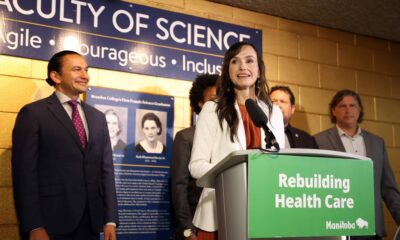Science
Unraveling Space-Time: What It Means for Our Reality

Space-time, a fundamental concept at the core of modern physics, has significantly altered our understanding of reality. Central to Albert Einstein’s theory of relativity, space-time is often depicted as a four-dimensional “block universe,” encapsulating all events—past, present, and future. Yet, the true nature of space-time remains a subject of intense debate, prompting critical questions regarding its existence and implications.
Understanding Space-Time and Its Implications
Space-time is frequently described as the “fabric of reality,” though interpretations vary. Some envision it as a static map, while others see it as a dynamic entity that bends and stretches in response to gravity. This duality raises fundamental questions about what it means for space-time to exist: is it a structure, a substance, or merely a metaphor?
These inquiries are not merely philosophical; they are pivotal to how we interpret modern physics. The concept of space-time influences our understanding of general relativity, time travel, and even the origins of the universe. According to philosopher Ludwig Wittgenstein, issues arise when language becomes unclear, and this is notably evident in discussions about space-time.
Over the past century, terms such as “time,” “exist,” and “timeless” have been repurposed in scientific contexts, often leading to confusion about their meanings. In the philosophy of physics, particularly within the framework known as eternalism, “timeless” is interpreted literally. This view posits that all events across time are equally real, encapsulated within a four-dimensional structure.
The Nature of Existence in Space-Time
According to eternalism, the entire history of the universe exists simultaneously, with no real passage of time. In this context, the term “timeless” suggests that the universe does not unfold or change; it merely exists as a static block. This perspective introduces a significant dilemma: if all events are real and exist within this block, what does it mean for space-time itself to exist?
The distinction between existence and occurrence becomes crucial. For example, we can say an elephant exists if it is physically present. In contrast, if an elephant were to appear momentarily and vanish, it would not “exist” in the same way; it merely occurs. This analogy compels us to consider whether space-time exists in a similar manner. Does it endure over time, or is it merely a framework for understanding events?
Furthermore, if every event throughout the universe’s history exists within this block, we must question when the block itself exists. If it is truly timeless, does it possess its own dimension of time? This line of inquiry leads to the idea of constructing a five-dimensional framework, incorporating additional temporal dimensions to better elucidate how space-time exists as we understand physical objects.
Such explorations push the boundaries of established physics, yet they reveal the challenges in discussing space-time’s existence without reintroducing concepts of time that complicate our understanding.
Space-Time in Popular Culture and Science
The confusion surrounding space-time shapes its portrayal in popular culture and science fiction. For instance, in the 1984 film The Terminator, time travel is depicted as fixed, with events preordained and unchangeable. Conversely, Avengers: Endgame presents time travel as a mechanism that allows characters to alter past events, suggesting a more fluid interpretation of the timeline.
Both narratives assume a fixed past and future, engaging with the implications of space-time’s existence without addressing the underlying complexities involved. These representations highlight the need for clarity in how we discuss space-time and its implications for our understanding of reality.
When physicists assert that space-time “exists,” they often navigate a complex framework that blurs the lines between existence and occurrence. This ambiguity can lead to a metaphysical model that lacks clarity, potentially obscuring our grasp of reality.
Despite these challenges, the mathematical foundations of relativity remain robust. Einstein’s equations continue to provide accurate predictions about the universe. How we interpret these equations has profound implications, particularly as we seek to reconcile general relativity with quantum theory.
Ultimately, defining space-time transcends a mere technical discussion; it shapes our conceptualization of the world we inhabit. The exploration of these ideas is not just an academic exercise but a fundamental inquiry into the nature of existence itself.
This investigation into space-time underscores the necessity of clear communication in both scientific and philosophical discourse, ensuring that the complexities of our universe are understood with precision and depth.
-

 Education2 months ago
Education2 months agoBrandon University’s Failed $5 Million Project Sparks Oversight Review
-

 Lifestyle3 months ago
Lifestyle3 months agoWinnipeg Celebrates Culinary Creativity During Le Burger Week 2025
-

 Science3 months ago
Science3 months agoMicrosoft Confirms U.S. Law Overrules Canadian Data Sovereignty
-

 Health3 months ago
Health3 months agoMontreal’s Groupe Marcelle Leads Canadian Cosmetic Industry Growth
-

 Science3 months ago
Science3 months agoTech Innovator Amandipp Singh Transforms Hiring for Disabled
-

 Technology3 months ago
Technology3 months agoDragon Ball: Sparking! Zero Launching on Switch and Switch 2 This November
-

 Education3 months ago
Education3 months agoRed River College Launches New Programs to Address Industry Needs
-

 Technology3 months ago
Technology3 months agoGoogle Pixel 10 Pro Fold Specs Unveiled Ahead of Launch
-

 Technology1 month ago
Technology1 month agoDiscord Faces Serious Security Breach Affecting Millions
-

 Business2 months ago
Business2 months agoRocket Lab Reports Strong Q2 2025 Revenue Growth and Future Plans
-

 Science3 months ago
Science3 months agoChina’s Wukong Spacesuit Sets New Standard for AI in Space
-

 Education3 months ago
Education3 months agoAlberta Teachers’ Strike: Potential Impacts on Students and Families
-

 Technology3 months ago
Technology3 months agoWorld of Warcraft Players Buzz Over 19-Quest Bee Challenge
-

 Business3 months ago
Business3 months agoNew Estimates Reveal ChatGPT-5 Energy Use Could Soar
-

 Business3 months ago
Business3 months agoDawson City Residents Rally Around Buy Canadian Movement
-

 Education3 months ago
Education3 months agoNew SĆIȺNEW̱ SṮEȽIṮḴEȽ Elementary Opens in Langford for 2025/2026 Year
-

 Technology1 month ago
Technology1 month agoHuawei MatePad 12X Redefines Tablet Experience for Professionals
-

 Technology3 months ago
Technology3 months agoFuture Entertainment Launches DDoD with Gameplay Trailer Showcase
-

 Business3 months ago
Business3 months agoBNA Brewing to Open New Bowling Alley in Downtown Penticton
-

 Technology3 months ago
Technology3 months agoGlobal Launch of Ragnarok M: Classic Set for September 3, 2025
-

 Technology3 months ago
Technology3 months agoInnovative 140W GaN Travel Adapter Combines Power and Convenience
-

 Science3 months ago
Science3 months agoXi Labs Innovates with New AI Operating System Set for 2025 Launch
-

 Technology3 months ago
Technology3 months agoNew IDR01 Smart Ring Offers Advanced Sports Tracking for $169
-

 Technology3 months ago
Technology3 months agoDiscover the Relaxing Charm of Tiny Bookshop: A Cozy Gaming Escape










